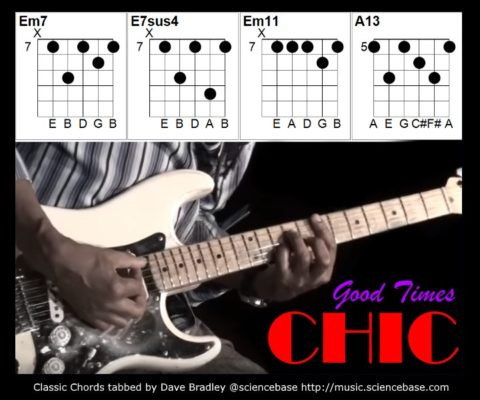“Good Times” by Chic is more than just a disco anthem; it’s a masterclass in funk guitar and songwriting, instantly recognizable and endlessly influential. For musicians aiming to capture that iconic Chic sound, nailing the chords is crucial. Many online resources offer approximations, but to truly get it right, you need to dive deeper into how Nile Rodgers, the guitar virtuoso behind Chic, actually plays it. This guide breaks down the definitive chords for the chorus of “Good Times”, straight from the source himself, ensuring your rendition hits all the right notes.
Many guitarists find themselves playing chord progressions for “Good Times” that are close but not quite the authentic sound. Standard chord charts often simplify the harmonic richness that Rodgers brings to the track. For years, even seasoned players might have been jamming along with charts suggesting a progression revolving around Em7, E7sus4, and Asus4, perhaps substituting a Dmaj7 for a more jazzy feel before resolving to an A13. While these chords capture the general vibe, they miss the specific nuances that make the Chic sound so distinctive.

The key to unlocking the authentic “Good Times” chorus lies in a subtle yet significant chord change. While Em7 and E7sus4 are indeed the starting point, the crucial bridge between these and the A13 chord isn’t a simple Asus4 or Dmaj7. Instead, Nile Rodgers utilizes an Em11 chord to create that signature harmonic movement. In live performances, Rodgers himself clarifies that the chorus chords are Em7, E7sus4, Em11 at the seventh fret, resolving to A13 at the fifth fret. Interestingly, on the original recording, that Em11 voicing is actually an A7sus4 played at the fifth fret, a detail that further underscores Rodgers’ sophisticated chord vocabulary. For the verses, the harmonic landscape simplifies to Em7 and Asus4, moving to A, providing a contrasting texture to the chorus’s complexity.
Beyond just the chord names, understanding Nile Rodgers’ playing style is essential for capturing the true essence of “Good Times”. Unlike guitarists who might broadly strum across the fretboard, Rodgers’ approach is remarkably precise and rhythmic. He favors triad voicings, using his pick to articulate chunks of chords, bouncing between higher and lower notes. This technique, combined with heavy left-hand muting and percussive silences, creates the “chunky” and “choppy” sixteenth-note rhythm that defines his funk guitar style. It’s a style rooted in jazz sensibilities, disguised within the infectious groove of funk.
“Good Times” isn’t just a song; it’s a cultural touchstone. Its iconic bassline and infectious rhythm have made it one of the most sampled tracks in music history, famously forming the backbone of Sugarhill Gang’s “Rapper’s Delight” and countless others. This enduring legacy speaks volumes about the song’s timeless appeal and Nile Rodgers’ genius as a musician and songwriter.
So, ditch the simplified chord charts and embrace the authentic harmonic richness of “Good Times”. By incorporating the Em11 (or A7sus4) in the chorus and understanding Nile Rodgers’ unique playing style, you can unlock the true groove of this disco and funk classic and truly play it right.

